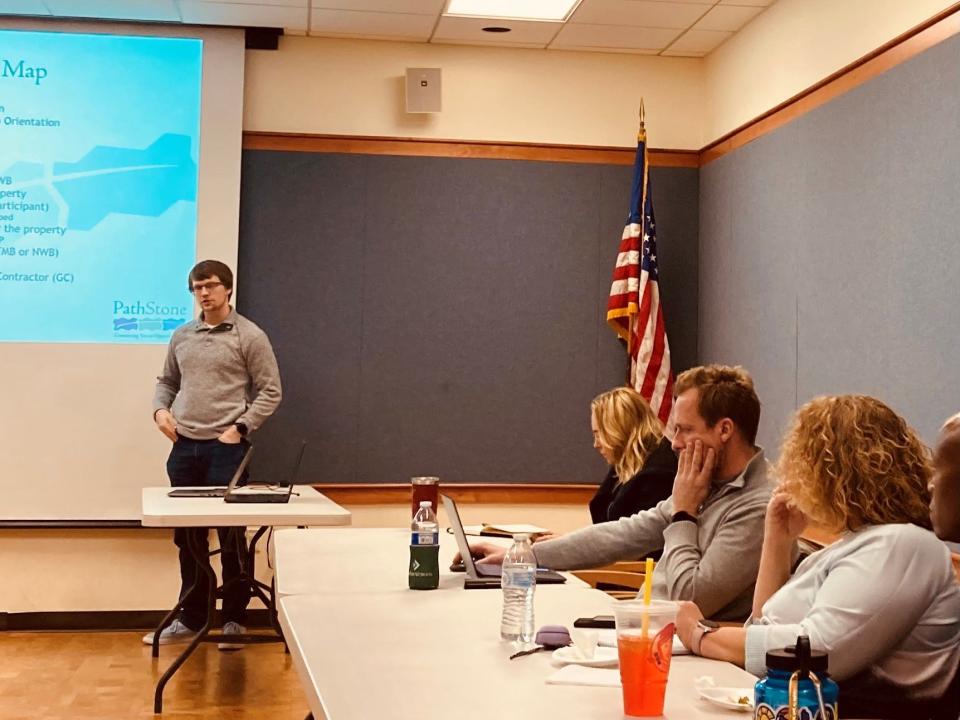Ridding Muncie of blight, house by house
MUNCIE, Ind. − The most recent programs announced by the city administration have been taking an approach to stabilize neighborhoods on the margins and rebuild neighborhoods infected with blight, The city is using single homes or duplexes to improve a block, rebuilding a neighborhood the way it was built the first time − house by house.

The concept was expanded last week by Nate Howard, executive director of the Muncie Land Bank, at the agency's First Friday talk.
Each month the agency invites the public for lunch and a chance to talk at the Maring-Hunt Branch of the Muncie Public Library. February's discussion dealt with infill, the practice of helping fix a neighborhood by remodeling a single ramshackle home or filling in a vacant lot with a new house where blight had previously claimed a home.
In late January, the city administration said 45 new residences would be built as affordable housing on top of its previously announced City View project, which also build is building homes in low-income neighborhoods on a rent-to-own basis.
More:New city housing effort scatters dwellings across five neighborhoods
Meanwhile, Brandon Lien, deputy director of community programs with a nonprofit called Pathstone, told the First Friday group that his agency has funding to help five people renovate empty houses into livable homes.
Lien said that thanks to a $100,000 grant from city American Rescue Plan funds, Pathstone can assist low income buyers from purchase through remodeling to bring a dwelling up to par, or better. The program helps to provide low-income families with a chance to own a home of higher quality than they could otherwise afford in a neighborhood that needs the investment.
Lien said Pathstone aims to help improve the aging housing stock in Muncie.
Those interested in the program can contact Pathstone at (765) 286-2162.
Also presenting at the First Friday meeting was Tom Collins, Ball State University associate professor of architecture, who discussed the university's work building a home in an Indianapolis neighborhood, providing infill in a market where private developers often build new homes in old neighborhoods.
"There's a massive amount of infill up College Avenue and in Fountain Square Neighborhood," he said.
BSU, through its satellite campus in Indianapolis, is building a home designed by students on Temple Avenue in Indianapolis designed by students. But the Indianapolis market, for whatever reason, is different from Muncie. The infill homes in Indianapolis are usually sold at market rate. Collins said.
More:Muncie Land Bank moving vacant properties back into use in city neighborhoods
The professor then discussed an infill project in South Bend. The city has approved five different house designs: A carriage home style, a two-story duplex, a standard single family house, a house designed to sit on a narrow lot and a six-unit apartment building.
The different styles create variety. Designs have already been approved for use within South Bend with permit approval waiting, that makes the process easier and less expensive for the homeowner or developer.
Collins said the design component of a home can cost as much as $20,000. The plans are simple and provide builders with the fundamentals going into the project.
He said Muncie could look at doing something similar. The South Bend mayor said the effort is aimed at accomplishing something Muncie is also trying to do − build population density in the inner core of the city.
The South Bend designs already all fall in line with the house designs in the older neighborhoods.
About 25 people attended the First Friday meeting. Some mentioned the challenges facing infill projects, including getting mortgage financing for a new home in a neighborhood where there are no recent comparable houses that have sold as well as the risk of investing a lot of money in neighborhoods that have been deteriorating.
The Land Bank exists to acquire land and put idle properties back into good use in areas needing investment.
The next First Friday event will be March 3 at 12:30 p.m. in the Maring-Hunt Branch. The public is welcome. Lunch is provided and there is no charge. The speaker will be announced prior to the meeting.
This article originally appeared on Muncie Star Press: Ridding Muncie blight house by house

